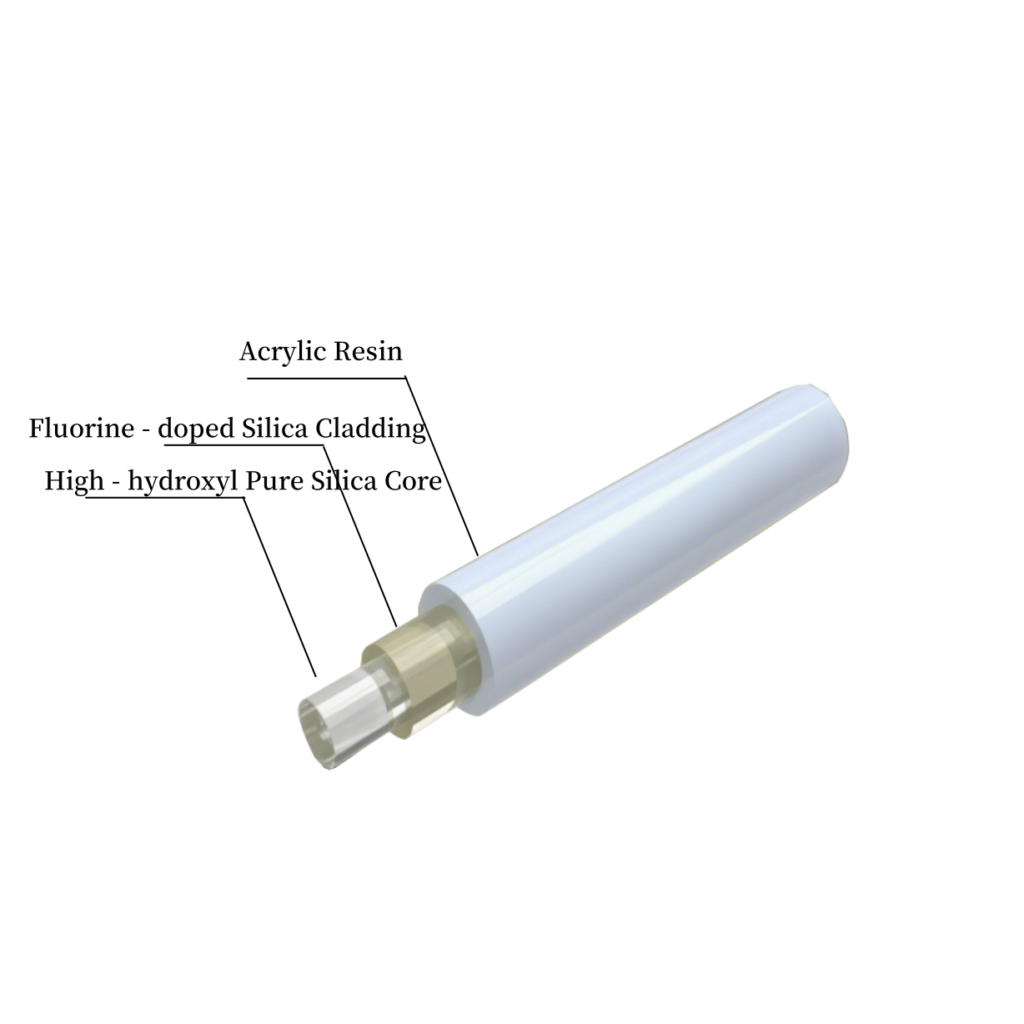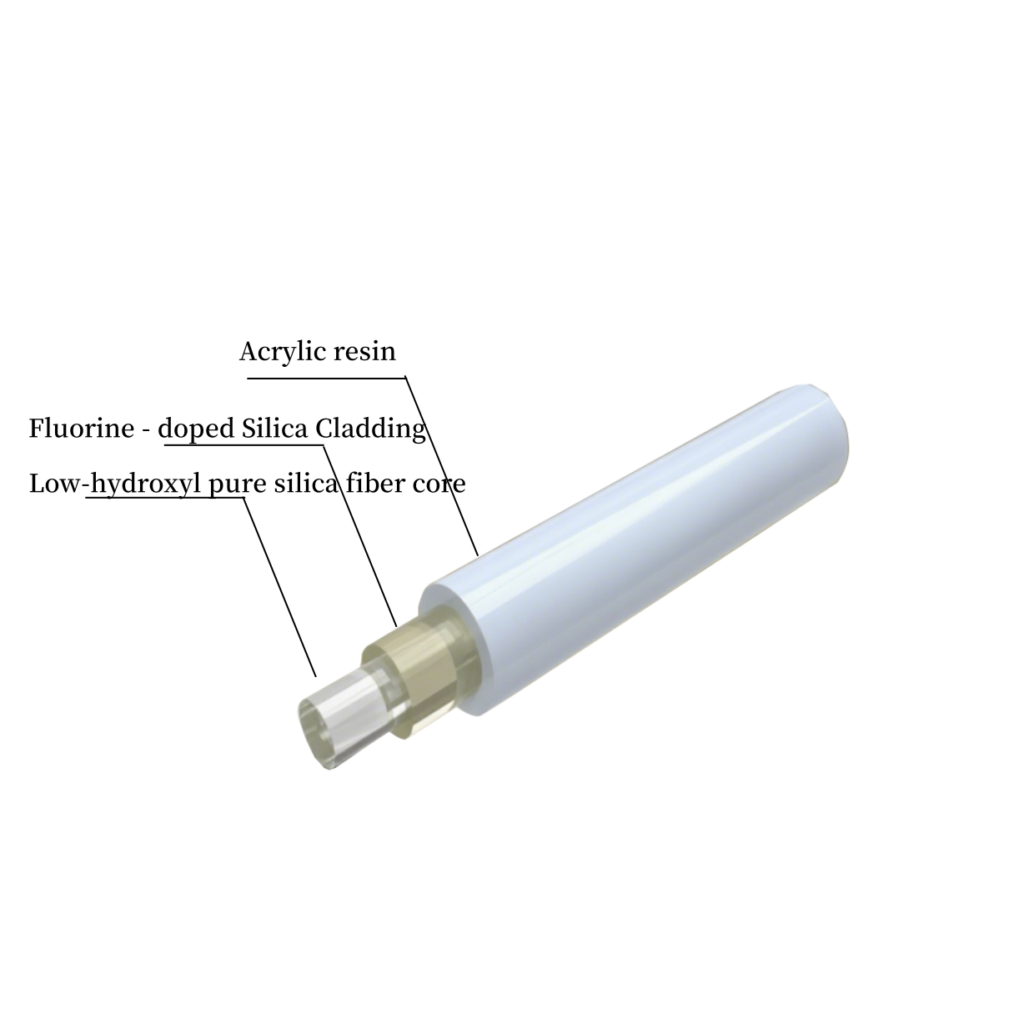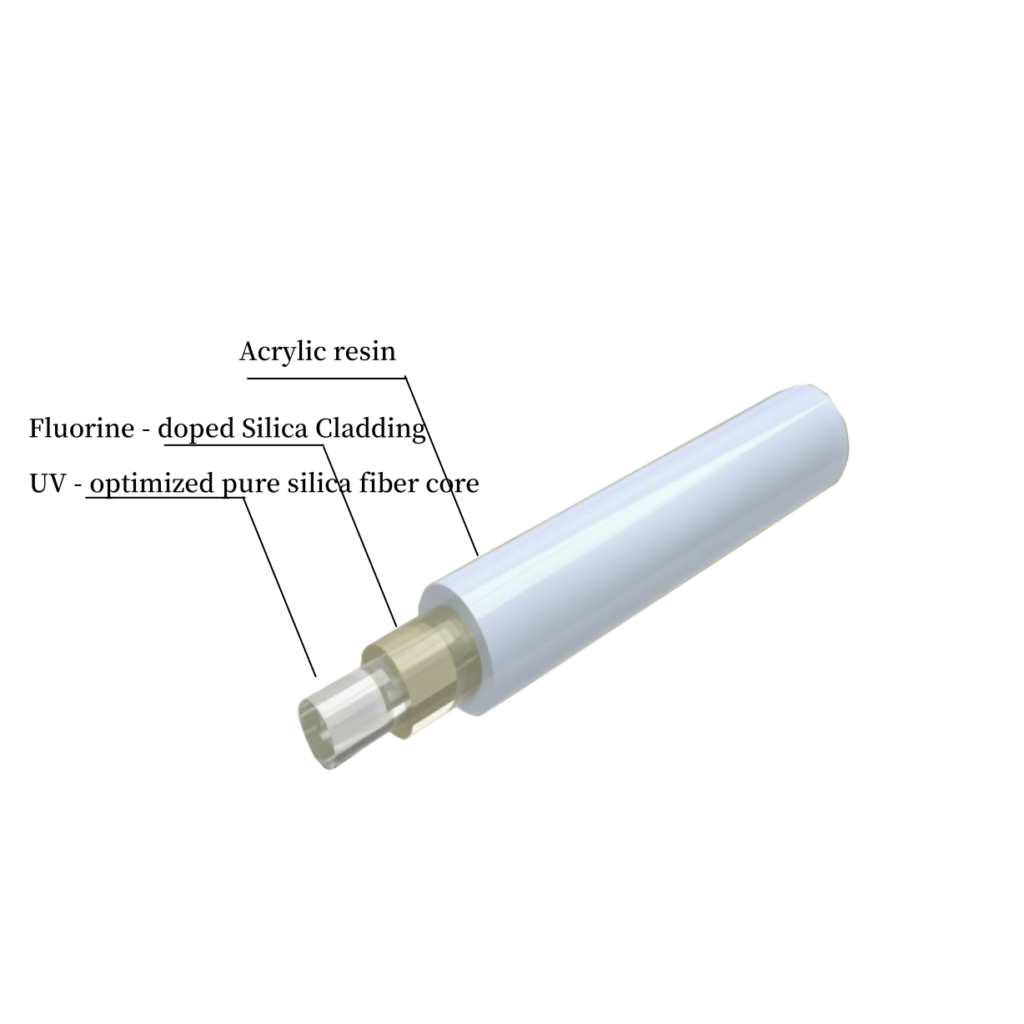Fiber
- UV Fused Silica Fiber
- Infrared Optical Fiber
- UV-Resistant Quartz Optical Fiber
- Polyimide Optical Fiber
- Hard Clad Silica Fiber (HCS Fiber)
- Square-Core Energy-Homogenizing Optical Fiber

| Core | Cladding | Coating / Jacket | Spectral Range(nm) | Numerical Aperture (NA) |
| 50 | 125 | 245 | 200-1100 | 0.22 |
| 100 | 110 | 130 | 200-1100 | 0.22 |
| 200 | 220 | 320 | 200-1100 | 0.22 |
| 300 | 330 | 520 | 200-1100 | 0.22 |
| 400 | 440 | 700 | 200-1100 | 0.22 |
| 600 | 660 | 900 | 200-1100 | 0.22 |
| 800 | 880 | 1100 | 200-1100 | 0.22 |
| 1000 | 1050 | 1600 | 200-1100 | 0.22 |
| 1000 | 1100 | 1600 | 200-1100 | 0.22 |
UV Fused Silica Fiber
UV Fused Silica Fiber is a type of optical fiber made from fused silica, which exhibits excellent optical transmission characteristics in the ultraviolet spectral range (approximately 200nm to 400nm).
Broad Spectral Range: UV fused silica fiber exhibits good transmission characteristics in the ultraviolet spectral range of 200nm to 400nm, while also providing certain transmission efficiency in the visible and near-infrared spectral ranges.
High Corrosion Resistance: Silica fiber has strong resistance to chemical corrosion and can be used in harsh environments, such as high temperature, high pressure, and corrosive gas conditions.
High Mechanical Strength: Compared with other types of ultraviolet fibers, silica fiber has higher mechanical strength and tensile strength, making it more suitable for use in occasions with significant changes in the physical environment.
High Temperature Resistance: UV fused silica fiber has good high-temperature resistance and is highly suitable for optical transmission in high-temperature working conditions.
Radiation Resistance: UV fused silica fiber has high radiation resistance and can operate normally in strong radiation environments.

| Core | Cladding | Coating / Jacket | Spectral Range(nm) | Numerical Aperture (NA) |
| 50 | 125 | 245 | 400-2500 | 0.22 |
| 105 | 125 | 245 | 400-2500 | 0.22 |
| 135 | 155 | 320 | 400-2500 | 0.22 |
| 200 | 220 | 320 | 400-2500 | 0.22 |
| 300 | 330 | 520 | 400-2500 | 0.22 |
| 400 | 440 | 700 | 400-2500 | 0.22 |
| 600 | 660 | 900 | 400-2500 | 0.22 |
| 800 | 880 | 1100 | 400-2500 | 0.22 |
| 1000 | 1100 | 1600 | 400-2500 | 0.22 |
Infrared Optical Fiber
Near-infrared quartz optical fiber is a type of fiber designed for transmitting optical signals in the infrared wavelength range (0.4µm – 2.5µm).
Compared to common optical fibers such as multimode and single-mode fibers, it exhibits lower signal loss and superior light transmission performance in the infrared wavelength range.
Its excellent performance stems from:
- Efficient transmission of infrared light;
- Thermal stability, chemical resistance, and mechanical strength of quartz materials, enabling potential applications across diverse industries.

| Core | Cladding | Coating / Jacket | Spectral Range(nm) | Numerical Aperture (NA) |
| 100 | 110 | 130 | 190-1100 | 0.22 |
| 200 | 220 | 245 | 190-1100 | 0.22 |
| 400 | 440 | 700 | 190-1100 | 0.22 |
| 600 | 660 | 900 | 190-1100 | 0.22 |
UV-Resistant Quartz Optical Fiber
UV-resistant quartz optical fiber is a specialized type of fiber that uses special doping, rod-making, and drawing processes to maintain stable transmittance under intense ultraviolet (UV) irradiation. Its transmission wavelength covers 190 nm – 1100 nm (UV-aging-resistant models extend to 1200 nm), making it suitable for ultraviolet, visible, and near-infrared bands. It is ideal for applications requiring long-term UV exposure, such as spectral analysis, photolithography systems, and excimer laser transmission systems.
Unlike standard UV quartz fibers, whose transmittance decreases after prolonged exposure to strong UV light, UV-aging-resistant models optimize processes to ensure nearly unchanged transmittance even after 24 hours of UV irradiation. This gives them a significant performance advantage in spectral analysis and other high-demand UV environments.
